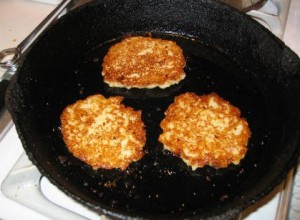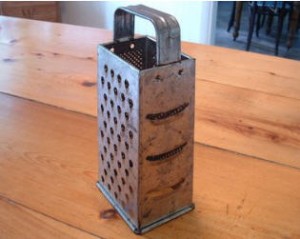
Latkes are potato pancakes. They’re a traditional food amongst many people, including Ashkenazi Jews – that would be both my parents. They’re generally eaten around Hanukkah, where the oil they’re cooked in symbolizes a miracle that was supposed to have happened a long time ago in the Middle East during a period when people were fighting and killing one another. We could probably use a few miracles in that area today.
In our household, latkes weren’t specifically a holiday food. They were just something my father would make whenever he had a mind to, which was pretty often, for example when his kids would hang on his arms and plead for latkes. They can be made as either an appetizer to a full meal, or – as a full breakfast meal in themselves with other breakfast-y things like ham, bacon, sausage and eggs. . .
I first learned to cook from my father, which was pretty unusual back in those days. He was a businessman, but he loved eating! Trained as an organic chemist, he also loved figuring things out – things like recipes were second nature to him.
I got older. Got married. Moved to Seattle. Kept cooking, couldn’t figure out *exactly* what it was that Pop did to make his latkes taste so damn’ good.
Pop got older. Ultimately, after Mom passed away, he moved from Massachusetts to live with our family in Seattle, where he stayed for fourteen years. During this time, he made latkes for us on a regular basis, and I got to check out his chops with a more adult perspective.
This is how he made them – and I found them perfect. Lacy, crisp, stunningly simple and painfully good.
I suggest you follow this particular recipe fairly closely the first time you try it out, then you’ll have a better feel for exactly the proportions of onion and salt that will bring you maximum joy.
Pop’s Latkes
This recipe will make enough latkes to fill 4-5 people up quite nicely, or 8 as a side dish with, say, ham and eggs. And – you’re right – we weren’t particularly observant Jews, certainly not where kosher dietary laws were concerned. Food was food in my folks’ book – and mine as well.
Ingredients
- About 2 lbs Yukon Gold potatoes peeled. Feeling adventurous? Experiment by using about 1.5 lbs of potatoes and a half pound of carrot, parsnip, sweet potato, yam, or even zucchini. These make a nice and flavorful addition, but are generally considered rank heresy in our household. So – if you haven’t made latkes before, do me a favor. Just use potatoes, then decide later if you want to try alternate ingredients. 🙂
- About a good half cup of grated onion (more on grating in a minute)
- Two large eggs, lightly beaten
- A teaspoon of fine sea salt. Or table salt – I defy you to tell the difference in a blind taste test for this particular dish! 🙂
- Coarse Kosher (or sea) salt, for sprinkling on top of the latkes when they’re done
- A Tablespoon and a half of flour
- Large bowl filled with cold water into which you’ve squeezed the juice of half a juicy lemon.
- Enough peanut oil (or vegetable oil or grapeseed oil) to fill your large 10″ ( or better, 12″) frypan about 1/2″ deep.
- A box grater. This is a critical piece of kitchen equipment. Do not use a food processor – you won’t get the same results.
Preparation – the Grater’s the Thing
Preheat your oven to 350 and pop a cookie sheet with a wire rack into it. Put a couple of paper towels on the rack. They will not burn.
This will hold your latkes in a warm, crisp state as you make ’em. Generally, whenever I make latkes, they seem to vanish – it’s like a magic trick – they disappear before I can get ’em to the oven. But you’ve gotta try, right??
- Peel the potatoes and grate them on the coarse openings of a standard kitchen box grater. In time, you’ll learn to do this with minimal scarring. As the potatoes collect inside the grater, pop them out and into the bowl of cold water with lemon juice. This keeps them from browning and helps them crisp up a bit more.
- Use a white onion. Grate it against the small holes of your box grater. This can take a little patience. You’ll end up with a kind of particulate mush. You want a solid half-cup of this particulate mush, which is in the range of about half a good sized white onion.
- Drain the shredded potatoes, then put them in a large clean kitchen cloth and squeeze the bejeezus out of them, twisting the cloth tightly to squeeze out as much liquid as possible. Or, you could use a salad spinner and finish drying ’em with paper towels.
- Put the mostly-dried potato shreds into a bowl, add the mushy particular onion bits, the salt, the two beaten eggs, the flour, and mix gently but thoroughly.
- Pour about 1/2″ oil into your large fry pan. . .let me digress: If you have one of those electric frypans – I have an old Farberware that used to belong to my Pop – they work better for any kind of quasi-deep frying because they’ll keep the hot oil or fat at a constant temperature without having to fiddle with the stove.
- Heat ’til it’s shimmering, but not close to smoking. If you take a spoonful of the potato mixture and plop it into the oil, it should begin sizzling nicely almost immediately. Cook this spoonful and eat it. People will crowd around asking for their latkes, but the chef always gets the tester.
- Take a large spoonful of the potato mixture and pour/scrape it into the oil. It will flatten out and form a circle. Approximately! You can make 3–4-5 of these at once depending on the size of your frypan, but do not crowd the latkes. Crowding the latkes just makes them irritable, and generates more steam than heat.
- When the latkes begin to bubble on top, slide a spatula under them and gently turn them over, cooking for another minute or so until they’re browned lightly on both sides.
- Transfer batch of latkes to a plate with paper towels to absorb the oil, sprinkle with just a pinch of coarse salt (Kosher or coarse sea salt). Have one of your kitchen minions take the plate and gently move the latkes to the wire rack in the stove. In my experience, this is where the greatest inventory shrinkage occurs, so you may want to do this yourself, or just put them directly in the stove.
- When the oil’s come back up to temperature, repeat until you’ve used all your potato mixture. Weep that you did not make more. If you’re not using an electric fry pan, keep adjusting the heat so it stays approximately the same. Depending on the size of your pan and the heat source, you may need to turn it down a little or up a little.
Serve immediately. Our daughter has discovered that you can put latkes wrapped in paper towels in an airtight plastic container and they’ll keep well enough to reheat in the stove for a day or two – but they’re really not the same.
You’ve made your latke, you’ve salted your latke – now what do you put on top of your latke?
This is a question that’s caused arguments for generations. It’s much like the question about borscht: sweet and sour or tomato, garlic and bay? I can only say let your conscience be your guide – I’ve included a number of traditional toppings, but me – I just like ’em straight out of the sizzling oil, with a little pinch of coarse salt. Ultimate Nom! After all, these are finger foods, and are definitely improved with condiments. I just happen to love the simple, pure taste of the primary ingredients.
Many people who eat latkes as a traditional Hanukkah dish eat them for the eight nights of Hanukkah, so it’s clear a little variety might be in order! Bring on the condiments!
Traditional Toppings for Latkes
- Applesauce – the King of the sweet toppings
- Sour cream (or plain Greek yogurt) – the King of the somewhat more savory toppings
- Any kind of chutney
- Caramelized onions or shallot
- A nice apple or pear compote. A little ginger is excellent in either of these. Compote is grown-up applesauce. Make a pear or apple / ginger compot by coarsely chopping up – wait for it – pear or apple, and adding it to a sauce pan with a tiny bit of water and a little sweetener. Then cook on low heat, stirring from time to time until all the bits soak up the liquid and soften up – usually 8-10 minutes.
- I have heard of people who put cranberry sauce on their latkes. It’s certainly a great nod to diversity – I’ve never personally tried it, but I would, it sounds like a great blend. Tart-sweet cranberries atop the succulent latke. . .




